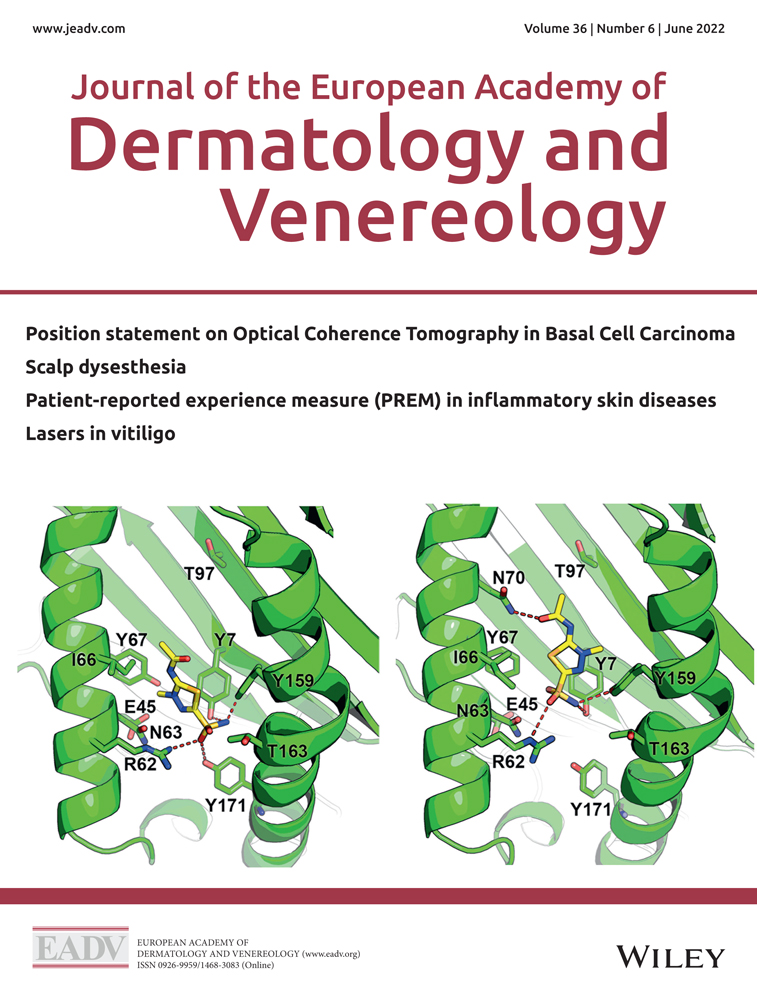Unique motif shared by HLA-B*59:01 and HLA-B*55:02 is associated with methazolamide-induced Stevens–Johnson syndrome and toxic epidermal necrolysis in Han Chinese
Conflicts of interest
None to declare.
Funding sources
This work was supported by the National Natural Science Foundation of China [grant 81872525, 81472873, 31972880], National Key Research and Development Program [grant 2016YFC0905000, 2016 YFC0905001], Natural Science Foundation of Henan Province [grant 182300410010] and Shanghai Municipal Commission of Science and Technology Research Project [grant 19JC1411000].
Abstract
Background
Methazolamide (MTZ) has been occasionally linked to the lethal Stevens–Johnson syndrome (SJS) and toxic epidermal necrolysis (TEN), which are associated with HLA-B*59:01. However, some MTZ-induced SJS/TEN (MTZ-SJS/TEN) cases are negative for HLA-B*59:01, implying that other genetic factors besides HLA-B*59:01 are contributing to MTZ-SJS/TEN.
Objectives
To comprehensively identify HLA and non-HLA genetic susceptibility to MTZ-SJS/TEN in Han Chinese.
Methods
Eighteen patients with MTZ-SJS/TEN, 806 subjects of the population control and 74 MTZ-tolerant individuals were enrolled in this study. Both exome-wide and HLA-based association studies were conducted. Molecular docking analysis was employed to simulate the interactions between MTZ and risk HLA proteins.
Results
We found a strong signal in the major histocompatibility complex region on chromosome 6 with 22 SNPs reaching exome-wide significance. Compared with MTZ-tolerant controls, a significant association of HLA-B*59:01 with MTZ-SJS/TEN was validated [odds ratio (OR) = 146.00, 95% confidence interval (CI): 16.12–1321.98; P = 6.19 × 10−10]. Moreover, 66.7% of MTZ-SJS/TEN patients negative for HLA-B*59:01 were carriers of HLA-B*55:02, whilst 2.7% of the tolerant individuals were observed with HLA-B*55:02 (OR = 71.00, 95% CI: 7.84–643.10; P = 1.43 × 10−4). Within HLA-B protein, the E45-L116 motif could completely explain the association of HLA-B*59:01 and HLA-B*55:02 with MTZ-SJS/TEN (OR = 119.33, 95% CI: 29.19–1227.96; P = 4.36 × 10−13). Molecular docking analysis indicated that MTZ binds more stably to the pocket of HLA-B*59:01 and HLA-B*55:02 than to that of non-risk alleles of HLA-B*40:01 and HLA-C*01:02.
Conclusions
This study confirmed the association of HLA-B*59:01 with MTZ-SJS/TEN and identified HLA-B*55:02 as a novel risk allele in Han Chinese with the largest sample size to date. Notably, the rs41562914(A)-rs12697944(A) haplotype, encoding E45-L116, is capable of serving as a powerful genetic predictor for MTZ-SJS/TEN with a sensitivity of 89% and specificity of 96%.
Abstract
Linked Commentary: P.-W. Huang and C.-Y. Chu. J Eur Acad Dermatol Venereol 2022; 36: 764. https://doi.org/10.1111/jdv.18158.
Open Research
Data Availability Statement
The data that support the findings of this study are available from the corresponding author, X. Luo and Q. Xing, upon reasonable request.




